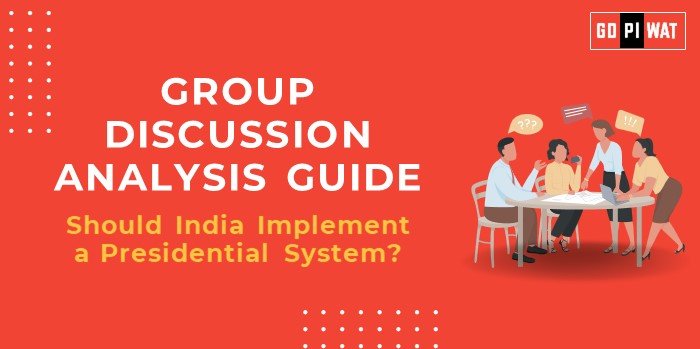📋 GD Analysis Guide: Should India Implement a Presidential System?
🌐 Introduction to the Topic
India, the world’s largest democracy, operates under a parliamentary system inspired by the British model. The debate over adopting a presidential system raises questions about governance efficiency, accountability, and adaptability to India’s diverse socio-political landscape. With calls for stronger central leadership amidst challenges in coalition politics, this topic holds significant relevance for future leaders.
📊 Quick Facts and Key Statistics
• 🤝 Coalition Governments in India: Since independence, India has experienced over 30 coalition governments, highlighting the complexities of its parliamentary system.
• 📈 Governance Rankings: India ranked 46th in the Economist Intelligence Unit’s 2023 Democracy Index, indicating areas for improvement in its democratic processes.
• 💰 Election Expenditure: The 2019 general elections in India were among the most expensive globally, with expenditures exceeding ₹60,000 crore.
• 🏛️ Presidential Role in India: Under Articles 52-78 of the Indian Constitution, the President’s role is largely ceremonial, with executive powers vested in the Council of Ministers.
🤔 Stakeholders and Their Roles
- 🏛️ Government and Political Parties: Key decision-makers in any constitutional reform, influencing the direction of governance structures.
- 👥 Citizens: Directly impacted by changes in governance, as such reforms affect representation and accountability.
- ⚖️ Judiciary: Ensures that any transition aligns with constitutional mandates and protects democratic principles.
- 🌍 International Comparisons: Countries like the United States (presidential system) and the United Kingdom (parliamentary system) offer models for analysis and comparison.
🏆 Achievements and Challenges
✨ Achievements of the Current Parliamentary System
- 🌍 Inclusive Representation: The parliamentary system accommodates India’s vast diversity, allowing multiple regional and national parties to participate in governance.
- ⚖️ Accountability Mechanisms: Ministers are accountable to Parliament, ensuring checks and balances through regular questioning and debates.
- 🔄 Adaptability: The system has managed to function despite political fragmentation, maintaining democratic processes since independence.
⚠️ Challenges Leading to Presidential System Advocacy
- 💔 Political Instability: Frequent coalition governments have sometimes led to unstable administrations, affecting policy continuity.
- 🐢 Delayed Decision-Making: Bureaucratic hurdles and coalition negotiations can slow down the implementation of critical reforms.
- 🌟 Personality-Centric Politics: Elections often focus more on individual leaders than on party policies, influencing governance dynamics.
🌍 Global Comparisons
• United States: The presidential system allows for clear separation of powers but can lead to gridlock during divided government scenarios.
• France: Operates a semi-presidential system, balancing executive authority with parliamentary oversight, offering a hybrid model.
📚 Case Study
States like Gujarat have demonstrated effective governance under strong chief ministerial leadership, sparking discussions on centralized executive power within a parliamentary framework.
💡 Structured Arguments for Discussion
- ✅ Supporting Stance: “Adopting a presidential system could streamline decision-making processes, reducing bureaucratic delays inherent in coalition politics.”
- ❌ Opposing Stance: “A presidential system may concentrate power excessively, risking authoritarianism and undermining the inclusive representation vital in India’s diverse society.”
- ⚖️ Balanced Perspective: “While a presidential system offers potential for efficient governance, India’s pluralistic fabric necessitates a model that ensures both effective administration and broad-based representation.”
🔍 Effective Discussion Approaches
- 📊 Data-Driven Opening: “India has experienced over 30 coalition governments since independence, highlighting the challenges of political stability in its parliamentary system.”
- 🌐 Global Benchmarking: “The United States’ presidential system showcases decisive leadership but also faces challenges like policy gridlock during divided governments.”
💬 Counter-Argument Handling: “While centralized decision-making can enhance efficiency, it is crucial to maintain checks and balances to prevent the erosion of democratic freedoms.”
📈 Strategic Analysis of Strengths and Weaknesses
- ✅ Strengths: Potential for decisive leadership, streamlined policy implementation.
- ❌ Weaknesses: Risk of power concentration, potential marginalization of minority voices.
- 🌟 Opportunities: Reforming governance structures to enhance efficiency while safeguarding democratic values.
- ⚠️ Threats: Possibility of undermining federalism and the autonomy of regional governments.
📚 Connecting with B-School Applications
💼 Real-World Applications
- 📑 Policy Analysis Projects: Evaluating the impact of different governance models on economic development and social equity.
- 🧑🤝🧑 Leadership Studies: Understanding the balance between centralized authority and collaborative governance in organizational contexts.
📋 Sample Interview Questions
- ❓ “How would a shift to a presidential system impact India’s federal structure and state autonomy?”
- ❓ “Discuss the potential economic implications of transitioning from a parliamentary to a presidential system in India.”
💡 Insights for B-School Students: Analyzing governance models informs leadership strategies and change management in complex organizations.


